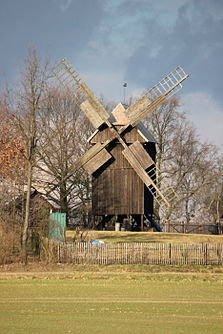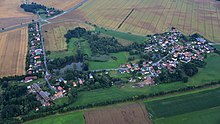Luga (Neschwitz)
|
Luga
Łuh commune Neschwitz
Coordinates: 51 ° 14 ′ 42 " N , 14 ° 20 ′ 47" E
|
|
|---|---|
| Height : | 158 m above sea level NN |
| Residents : | 337 (December 31, 2016) |
| Incorporation : | January 1, 1994 |
| Postal code : | 02699 |
| Area code : | 035933 |
|
The post mill between Luga and Quoos
|
|
Luga , Upper Sorbian , is a place in the center of the Bautzen district in East Saxony and has been part of the Neschwitz community since 1994 . The place lies in the Upper Lusatia and belongs to the settlement area of the Sorbs .
The German place name is derived from the Sorbian name, which means something like "swamp" or "moor" and is related to the regional name " Lausitz " ( Łužica ).
geography
Luga is located about ten kilometers northwest of the large district town of Bautzen in the floodplain of the Schwarzwasser , which flows here from the south in the direction of the Schwarze Elster . The castle pond is in the northern part of the village .
The neighboring towns are Quoos in the east, Krinitz in the west and Uebigau in the north-west.
history
The place was first mentioned in 1415 as Lugk . Until the 19th century he was under the manorial rule of the manor located here, which u. a. was owned by the von Schönberg family and from 1797 belonged to the diplomat Wilhelm August von Just and his brother for a few decades .
According to the plans for the Saxon Northeast Railway , its Radibor - Kamenz route should lead via Luga. However, the project failed due to the outbreak of the First World War and resistance from the Sorbian rural population.
Until 1993 Luga formed an independent rural community with the district Quoos (since 1936). On January 1, 1994, Luga was incorporated into Neschwitz and Quoos was reclassified to Radibor .
population
For his statistics on the Sorbian population in Upper Lusatia, Arnošt Muka determined a population of 344 inhabitants in the 1880s; 303 of them were Sorbs (88%) and 41 Germans. In 1956 Ernst Tschernik still counted a Sorbian-speaking share of 51.9% of the population in the municipality of Luga. Since then, the use of Sorbian in the village has continued to decline.
In 1925 Luga had 345 inhabitants, of which 302 were Protestant denominations (87%).
The place was a Protestant parish to Göda in the 16th century and came to Neschwitz in the 17th century after a brief membership of the Bautzen parish.
people
Richard Kuban, b. on October 27, 1891 in Luga (brother of Moritz Kuban, who died in World War I) NCO, awarded EKII and Silb. Military St. Heinrich Medal, was awarded the oldest Saxon military order, the Golden Military St. Heinrich Medal, on April 30, 1918 for his outstanding bravery. Brother Max became the first mayor after the Second World War .
Infrastructure
The B 96 (Bautzen– Hoyerswerda ) runs east of the village. The next junction of the A 4 ( Dresden - Görlitz ) is Salzenforst , eight kilometers south.
literature
- Cornelius Gurlitt : Luga. In: Descriptive representation of the older architectural and art monuments of the Kingdom of Saxony. 31. Booklet: Bautzen Official Authority (Part I) . CC Meinhold, Dresden 1908, p. 143.
- Book of honor of the holder of the Saxon Golden Military St. Heinrich Medal. 1936 p. 185.
Web links
- Luga in the Digital Historical Directory of Saxony




